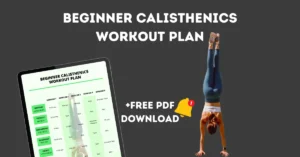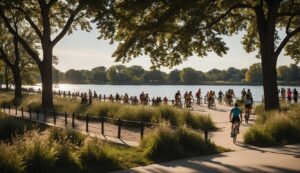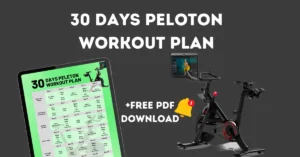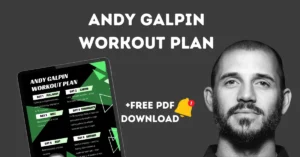📦 FREE Shipping
Free Beginner Triathlon Training Plan 2024 (+ PDF Download)
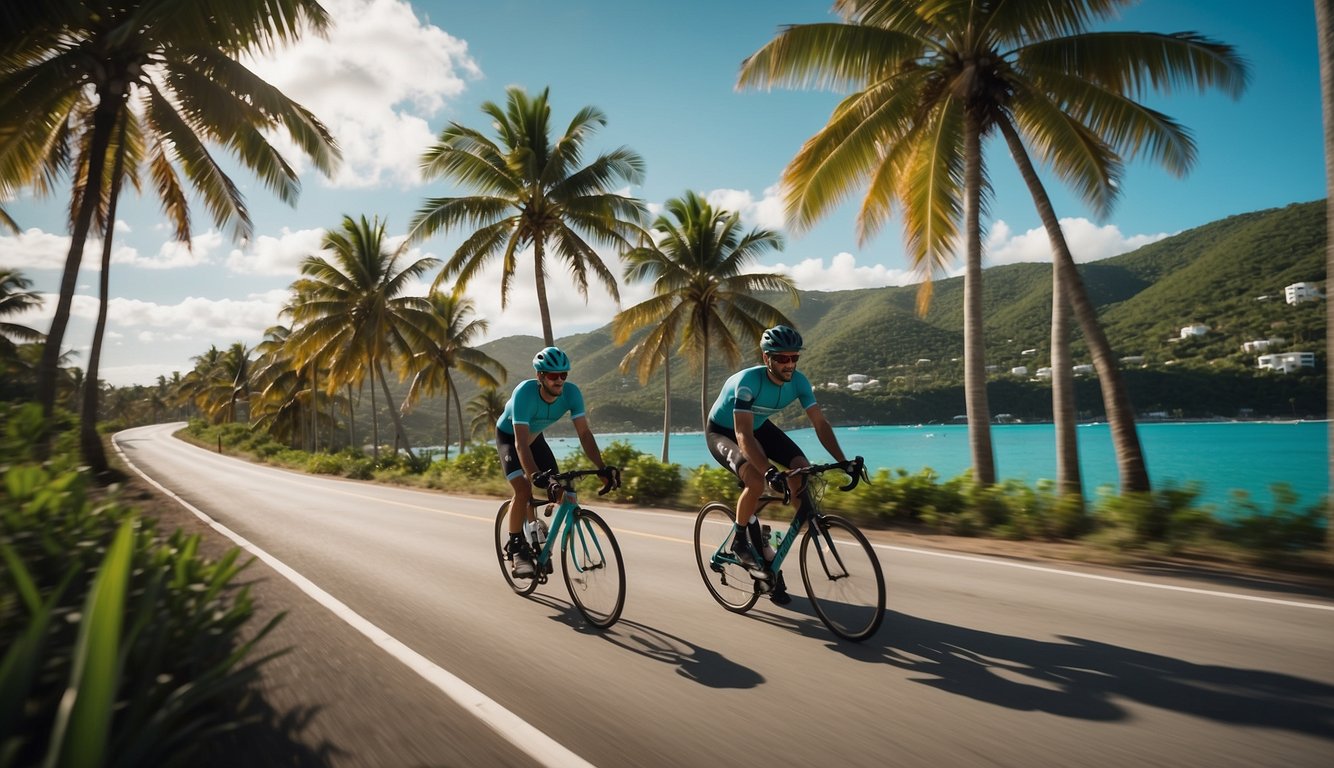
Embarking on the journey of training for my first triathlon was an exhilarating challenge that marked a bold step towards achieving a new level of fitness and personal accomplishment. A triathlon, which combines swimming, cycling, and running, is a testament to endurance and versatility, and as a beginner, I sought a training plan that was straightforward and tailored to my initial skill set. With no previous experience in the three disciplines, a structured beginner training plan was crucial for me to reach the finish line with confidence and a sense of achievement.
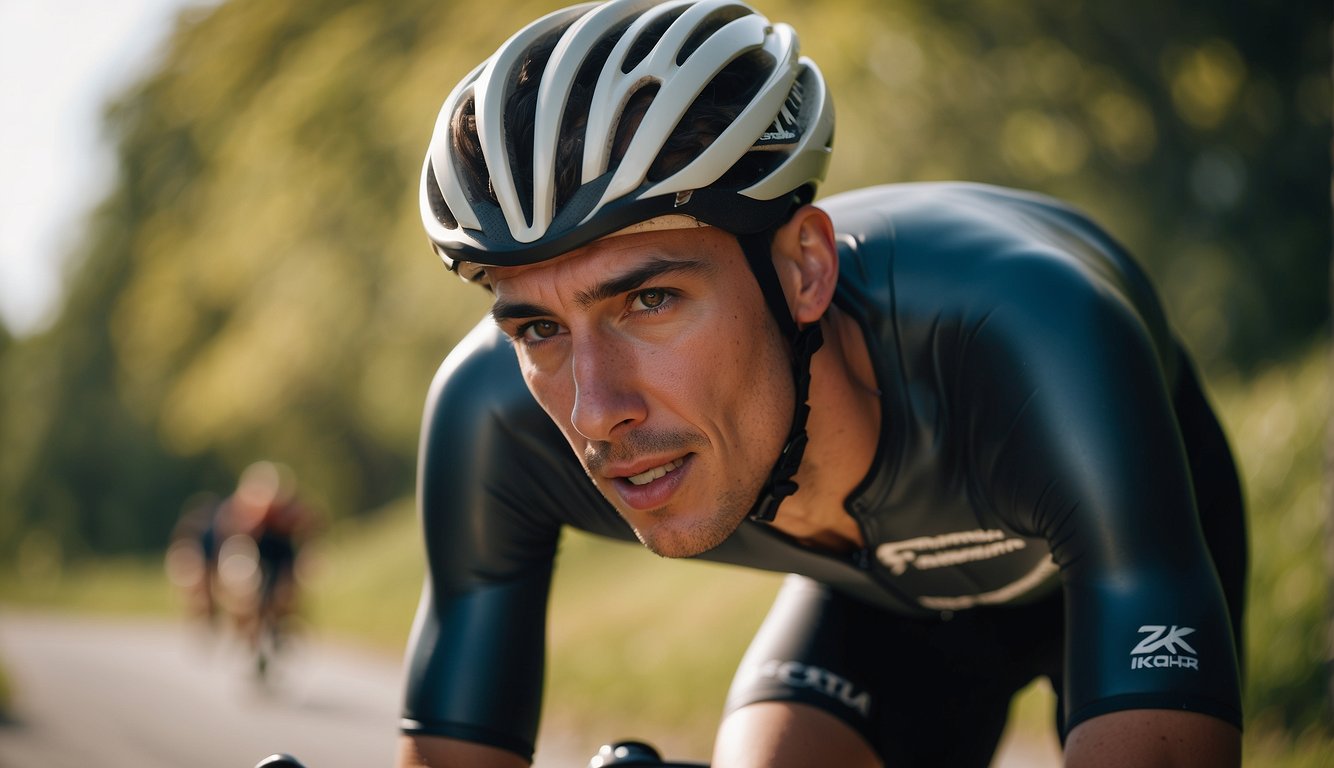
I discovered that starting with a sprint triathlon, which is the shortest standard triathlon distance, was the perfect launchpad. My beginner triathlon training plan focused on building stamina gradually across all three sports while paying attention to rest and recovery. The key elements of my plan included consistency, a balanced increase in intensity, and manageable workout segments that fit into my daily routine. With each week of training, I was able to witness tangible progress, not just in my physical capability but also in my mental resilience.
To ensure a well-rounded and injury-free preparation, my plan encompassed elements beyond the core workouts. This included techniques for efficient transitions, nutritional advice to fuel my body correctly, and mental strategies to stay motivated throughout the training period. I realized that diving into triathlon training as a beginner was not just about the physical preparation, but also about embracing a holistic approach to health and fitness. My excitement for the race day grew with every lap, pedal, and stride, making the journey towards the triathlon as rewarding as the event itself.
Getting Started: Your Beginner Triathlon Training Plan
Embarking on the journey of your first triathlon is a thrilling adventure! I’ll give you a sneak peek into the essentials of triathlon, the gear you’ll need, and how to gauge your current fitness level.
Triathlon Overview
Triathlons are multi-sport events consisting of swimming, cycling, and running—completed in succession without breaks in between. Beginners often start with the sprint distance, which usually includes a 750m swim, a 20km bike ride, and a 5km run. My main goal here is to familiarize you with the sport’s structure and encourage a smooth transition into triathlon training.
Gear Essentials
For a successful triathlon, the right gear is critical. Here’s a basic list of what you’ll need:
Swim:
- Wetsuit (if it’s cold or open water)
- Swimsuit or tri-suit
- Goggles
Bike:
- A road or triathlon-specific bike
- Triathlon Helmet (safety first!)
- Bike shorts or tri-suit
Run:
- Running shoes (comfort is king)
- Hat or visor (optional, but helpful)
As a beginner, I recommend focusing on the essentials and not getting overwhelmed with buying the most expensive equipment.
Determining Your Fitness Level
Understanding your starting point helps tailor your training to your needs. Here’s a simple way to assess your fitness:
- Swim: Test if you can comfortably complete a continuous 100-meter swim.
- Cycle: Check if you can bike for 30 minutes without strain.
- Run: See if you can run or walk/run for 15 minutes.
Adjust your training plan according to your initial fitness assessment and set realistic personal goals. Always remember to prioritize safety in training to avoid injury. With determination and the right preparation, I’m confident you’re going to crush your first triathlon!
Training Foundations
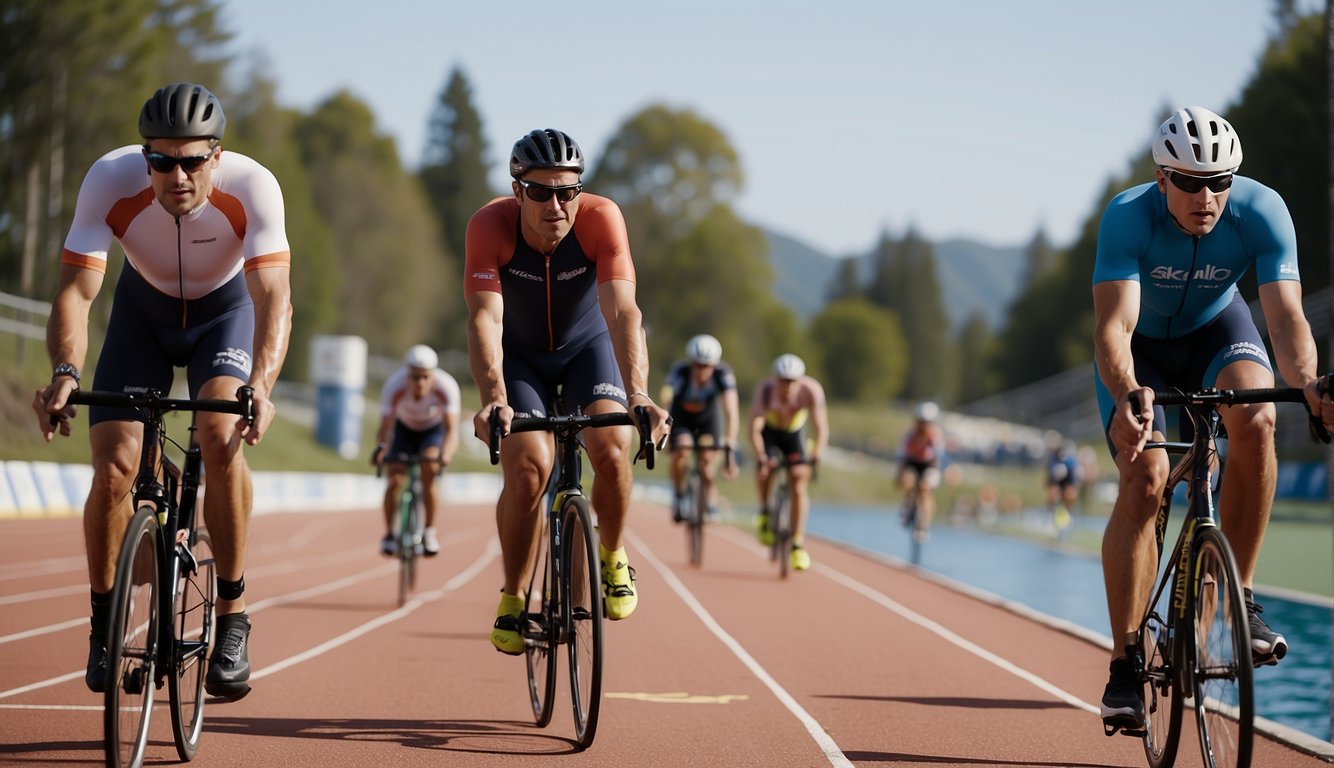
I’m thrilled to lay out the groundwork for your triathlon success! Before we deep dive into the specifics, let’s understand that a solid triathlon training plan is crucial for a strong start and steady progress. Additionally, focusing on nutrition and hydration can determine how effectively our bodies respond to training stimuli.
Components of a Triathlon Training Plan
A triathlon comprises swimming, cycling, and running. Each discipline requires dedicated attention, especially for a beginner. Here’s a concise break-down of stages within a typical training plan:
- Base Phase: Develop general fitness and endurance across all three sports to establish a resilient foundation.
- Build Phase: Intensify training workload and incorporate sport-specific skills to enhance performance.
- Peak Phase: Sharpen fitness and speed while beginning to taper in preparation for race day.
Remember, consistency and gradual progression are key. Here’s a recommended weekly training structure:
| Day | Discipline |
|---|---|
| Monday | Swim |
| Tuesday | Bike |
| Wednesday | Run |
| Thursday | Swim + Bike |
| Friday | Rest |
| Saturday | Long Bike |
| Sunday | Long Run |
Nutrition and Hydration Fundamentals
For me, nutrition and hydration are the unsung heroes of triathlon training. They fuel the engine that is our body and aid in recovery. While training, it’s vital that I pay attention to what and when I eat and drink. Some specifics include:
- Hydration: I drink water throughout the day and adjust my intake based on workout intensity and duration. Electrolyte-enhanced drinks are particularly beneficial during longer sessions to replace salts lost through sweat.
- Nutrition: Loading my diet with a balanced mix of carbohydrates (for energy), proteins (for muscle repair), and fats (for endurance) is a daily goal. Pre- and post-workout meals are timed to provide energy and facilitate recovery. For example, consuming a high-carb snack 30 minutes before training and a protein-rich meal within 30 minutes after training.
Ensuring I get enough nutrients helps not just with my training, but also with my overall well-being and life outside of triathlon preparation.
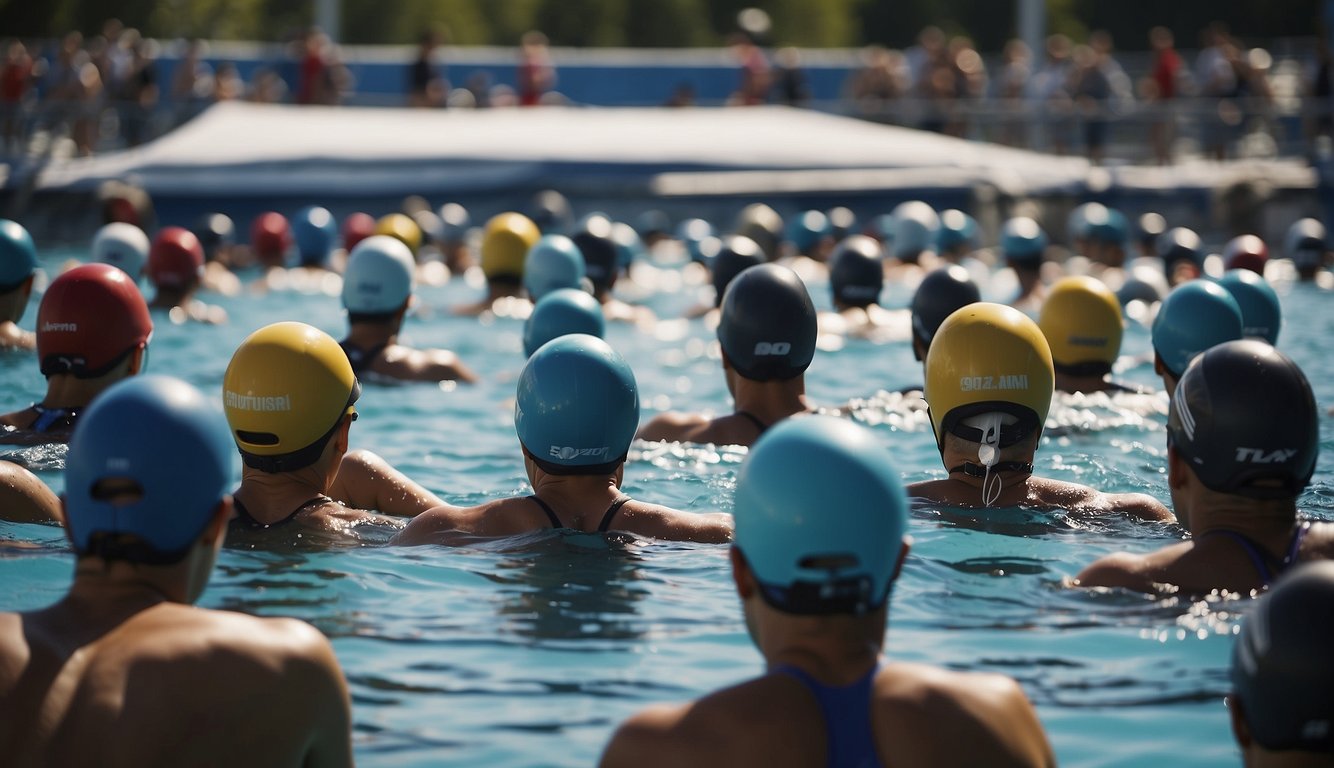
Discipline-Specific Workouts and Tips
In my journey to triathlon success, I’ve discovered that mastering discipline-specific workouts and tips is indispensable. From perfecting my swim technique to powerful endurance cycling sessions and strategic run workouts, each discipline requires unique focus and preparation. Here’s what I’ve learned:
Swim Training Techniques
For swim training, I start with the basics: wearing a comfortable wetsuit and swim cap to reduce drag, and a pair of reliable goggles to see clearly underwater. In the pool, I mix in a variety of swim drills, emphasizing technique and efficiency. Sessions are designed to build both endurance and speed, often starting with:
- Warm-up: 200 meters easy swim
- Main set: Repeated intervals, like 8 x 100 meters at a moderate pace
- Cool-down: 200 meters, slowing down the pace to relax
Swimming in open water can be different, so I make sure to practice sighting so I don’t veer off course during the race.
Cycling Sessions
Cycling requires adaptation to different terrains, so I include both flat routes and hills in my bike training. I use structured training to sharpen my pedaling efficiency and power. These cycling sessions might look like:
- Endurance ride: 90 minutes at a steady, manageable pace
- Intervals: 5 x 5 minutes at high intensity with rests in between
Investing in the right gear, like a fitting helmet and quality sunglasses, enhances my safety and performance.
Running Prep and Workouts
For running, I choose shoes that offer a mix of cushioning and support, key for both training and race day. Run training often consists of:
- Brick workout: A bike session followed immediately by a run to adapt to the transition
- Speedwork: Sets of shorter distances, such as 400-meter repeats, at a faster pace
Focused sessions enhance my speed and increase my running economy.
Transitions Between Disciplines
Transitions can make or break a race. I practice transition setups, trimming seconds off by streamlining the process of switching from swim to bike and bike to run. This is where I rehearse:
- T1: Quickly removing my wetsuit and putting on cycling gear
- T2: Efficiently switching from bike shoes to running shoes
Repetitive practice makes me faster and more confident during transitions on race day.
Recovery and Rest Days
Just as crucial as training, recovery and rest days are my body’s chance to repair and strengthen. I include recovery weeks where I reduce my workout intensity and volume, and my rest days are sacred—I might do gentle stretching or yoga, but I avoid intense physical exertion. Listening to my body is essential for showing up stronger in the next training phase.
Race Day Preparation
Preparing for race day is thrilling and a culmination of all my hard work. It’s essential to approach it with a strong strategy and ensure I’m mentally and physically primed.
Final Weeks Countdown
In the weeks leading up to the race, especially for sprint and Olympic distances which are my initial goals, I focus on tapering. Tapering is reducing my training volume and intensity to rest my body while maintaining fitness. I plan a few brick workouts, which are back-to-back sessions of different disciplines, to stay sharp. For example, a short sequence might include:
- Swim: 400 meters
- Transition: 5 minutes simulating race day
- Bike: 10 kilometers
- Transition: 5 minutes
- Run: 2.5 kilometers
I ensure I have all my gear ready and double-check the race rules and course details. Proper fueling is also critical, so I load up on healthy carbs and stay hydrated.
Mental and Physical Readiness
Race strategy is paramount; I lay out my plan, considering how I’ll pace myself through each leg, when and what I’ll eat for fueling, and how I’ll deal with pain or fatigue. Mental preparation involves visualizing each segment of the race, from the warm-up to the cool down. On race day morning, here’s my routine:
- Wake up early to have ample time for a light breakfast and hydration.
- Do a short warm-up to shake off any nerves and get blood flowing.
- Keep the mood light and stay focused on why I’m there—to enjoy the experience and do my best.
It’s a test of endurance and fitness level, but the training is the hardest part—race day is where I shine!
Frequently Asked Questions about Beginner Triathlon Training Plan
Embarking on the journey to my first triathlon was exhilarating! Let me share some pointers to help you get started and answer some common questions that triathlon newbies often have.
What’s the best way to start training for a triathlon if you’re a complete newbie?
I started by choosing a race and then creating a training schedule that allowed me to progressively build my fitness in swimming, cycling, and running. It’s important to ease into it to avoid injury.
How much time is typically required to train for a first triathlon?
I dedicated about 12-20 weeks to train for my first sprint triathlon, ensuring I had enough time to comfortably increase my stamina and strength across all three disciplines.
Are there any effective free training plans available for rookie triathletes?
Yes, I found several free training programs online tailored for beginners. These plans guided me through daily and weekly training routines covering all triathlon segments.
What does a 12-week triathlon training schedule look like for beginners?
My 12-week plan involved swimming, biking, and running workouts spread throughout the week, with incremental increases in duration and intensity, plus rest days for recovery.
Can I prepare adequately for a triathlon with just an 8-week sprint training program?
I successfully prepared for a sprint-distance triathlon with an 8-week plan, which was more intensive and required a good base level of fitness to begin with.
What are the essential tips for balancing swimming, cycling, and running in a beginner’s plan?
I ensured to balance my workouts, dedicating roughly equal time to each sport based on the triathlon’s distance proportions and including brick workouts to practice transitions.
Did you like this Beginner Triathlon Training Plan? Leave me a comment. Make sure to check out the Olympic Triathlon Training Plan and Triathlon Wetsuits as well.


